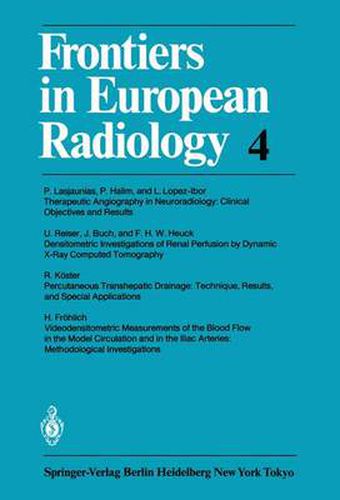Readings Newsletter
Become a Readings Member to make your shopping experience even easier.
Sign in or sign up for free!
You’re not far away from qualifying for FREE standard shipping within Australia
You’ve qualified for FREE standard shipping within Australia
The cart is loading…






This title is printed to order. This book may have been self-published. If so, we cannot guarantee the quality of the content. In the main most books will have gone through the editing process however some may not. We therefore suggest that you be aware of this before ordering this book. If in doubt check either the author or publisher’s details as we are unable to accept any returns unless they are faulty. Please contact us if you have any questions.
The quantitative analysis of blood flow within central and peripheral blood vessels has attracted more and more interest, for with the rapid developments in vascular surgery and the introduction of percutaneous transluminal angioplasty, it is becom ing increasingly important to be able to measure regional blood flow in man. In clinical radiology, angiography has been used predominantly from the point of view of its morphological applications. However, theoretically angiography may also be regarded as a specific application of indicator-dilution measurements of blood flow. The indicator is contrast medium (CM), the changing concentration of which is re corded by cinematography or video-electronic systems at sites downstream from the point of injection. The curves of density thus obtained correspond to indicator-di lution curves. The blood flow can be calculated from the concentration-time curves ofCM in much the same way as it is estimated from other indicator-dilution curves. In our early work with clinical application of videodensitometric measurement of blood flow in the iliac artery, we found that this method did not offer as high a degree of accuracy as one would have expected from investigations by other authors. We saw that we needed to examine the following problems: 1. We had to investigate whether our conventional X-ray equipment and video densitometer could be viewed as a linear measuring system. To what extent do unavoidable nonlinear changes in the measuring signals influence the blood flow values? 2.
$9.00 standard shipping within Australia
FREE standard shipping within Australia for orders over $100.00
Express & International shipping calculated at checkout
This title is printed to order. This book may have been self-published. If so, we cannot guarantee the quality of the content. In the main most books will have gone through the editing process however some may not. We therefore suggest that you be aware of this before ordering this book. If in doubt check either the author or publisher’s details as we are unable to accept any returns unless they are faulty. Please contact us if you have any questions.
The quantitative analysis of blood flow within central and peripheral blood vessels has attracted more and more interest, for with the rapid developments in vascular surgery and the introduction of percutaneous transluminal angioplasty, it is becom ing increasingly important to be able to measure regional blood flow in man. In clinical radiology, angiography has been used predominantly from the point of view of its morphological applications. However, theoretically angiography may also be regarded as a specific application of indicator-dilution measurements of blood flow. The indicator is contrast medium (CM), the changing concentration of which is re corded by cinematography or video-electronic systems at sites downstream from the point of injection. The curves of density thus obtained correspond to indicator-di lution curves. The blood flow can be calculated from the concentration-time curves ofCM in much the same way as it is estimated from other indicator-dilution curves. In our early work with clinical application of videodensitometric measurement of blood flow in the iliac artery, we found that this method did not offer as high a degree of accuracy as one would have expected from investigations by other authors. We saw that we needed to examine the following problems: 1. We had to investigate whether our conventional X-ray equipment and video densitometer could be viewed as a linear measuring system. To what extent do unavoidable nonlinear changes in the measuring signals influence the blood flow values? 2.